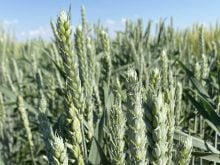Farmers with feed grains have an interesting marketing choice.
“What’s the best strategy? Dump it into an already cheap market” or hold and sell later into a market depressed by the big harvests that appear inevitable in the United States and Canada, said farm marketing adviser John Duvenaud.
“There’s going to be lots of feed around this year.”
Last year’s Aug. 20 frost left huge amounts of wheat, barley and oat crops that could only be sold as feed. Those stocks have weighed on the market for the past year, and now farmers have what looks like another big harvest coming in. They need to decide whether to clear out their bins now, or hang on until after the end of the traditionally weak harvest market.
Read Also

Grain farming’s hard times expected to continue
Rabobank says it will be two more years before North American grain farmers achieve break-even due to “monster” supplies and “sticky” crop input prices.
Adviser Errol Anderson said he thinks feed grain prices will be hammered down during harvest by farmers trying to clear bins and by commodity funds piling onto a downtrend.
Feedlots will probably take advantage of this by locking in a lot of supply or price protection. Producers would be smart to hold back on sales during the next few weeks when prices are likely to be unreasonably low, in the hopes of cheerier times after Christmas when feedlots will need more supply.
Duvenaud said the price damage caused by the big North American crops is likely to be mitigated by the drop in worldwide feed grain stocks, but it will take a while for that to appear.
“Globally there is reason for some optimism, but first we have to get through this North American harvest.”
Although Manitoba’s feed production has been ravaged by flooding, which cut acreage, and disease that might make much of the province’s feed grain production unusable by the hog industry, Duvenaud doesn’t see any bonanza for Saskatchewan and Alberta producers.
“Manitoba’s problems are vastly overbalanced by the good crops in Saskatchewan and Manitoba,” he said.
Alberta grain broker Doug Chambers said he thinks Manitoba’s difficulties, while not important for the overall feed grain situation, will provide some opportunities.
“People in eastern Saskatchewan need to get their barley (vomitoxin)-tested and malt tested as soon as possible,” said Chambers. “It’ll add a huge premium.”
Chambers foresees a saturated feed grain market, but one with more willingness to pay for product.
“There is going to be a more optimistic feeding industry because we have an open border,” said Chambers.
But for that to appear in the form of higher prices will take a few months, until after the harvest pressure has abated.















